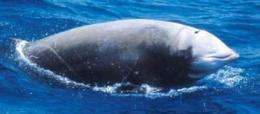Engineers design tools to study sound effects on whales

(�鶹��ԺOrg.com) -- A combination of the biology of marine mammals, mechanical vibrations and acoustics has led to a breakthrough discovery allowing scientists to better understand the potential harmful effects of sound on marine mammals such as whales and dolphins.
An international team of researchers from San Diego State University, UC San Diego, and the Kolmľrden Zoo in Sweden has developed an approach that integrates advanced computing, X-ray CT scanners, and modern computational methods that give a 3D simulated look inside the head of a Cuvier’s beaked whale.
“Our numerical analysis software can be used to conduct basic research into the mechanism of sound production and hearing in these whales, simulate exposure at sound pressure levels that would be impossible on live animals, or assess various mitigation strategies,” said Petr Krysl, a UC San Diego structural engineering professor who developed the computational methods for this research. “We believe that our research can enable us to understand, and eventually reduce, the potential negative effects of high intensity sound on marine organisms.”
The results of this research were recently published in a PLoS ONE article entitled, “A New Acoustic Portal into the Odontocete Ear and Vibrational Analysis of the Tympanoperiotic Complex” by Krysl, Ted W. Cranford, an adjunct professor of research in biology at San Diego State University; and Mats Amundin, a researcher at Sweden’s Kolmľrden Zoo. Sponsors of the research include the office of the Chief of Naval Operations (CNO), Environmental Readiness Division.
The model the researchers have developed creates a 3-dimensional virtual environment in which they can simulate sounds propagated through the virtual specimen and reveal the interactions between the sound and the anatomy. By having a virtual “peek” inside the whale’s head, the scientists are able to better understand and see how sound may impact or potentially harm marine life.
“Humans introduce considerable amounts of sound and noise into the oceans of the world,” Krysl said. “Many marine organisms make acute use of sound for their primary sensory modality because light penetrates so poorly into water. The primary focus of our work is Cuvier's beaked whale because some have stranded and died in the presence of Navy sonar. The discoveries we made with regard to the mechanisms of hearing in the beaked whale also apply to the bottlenose dolphin and, we suspect, to all types of toothed whales and perhaps other marine mammals.”
Krysl and his colleagues have been studying the effects sound has on marine life for the past nine years.

“This research program has a very strong experimental component, which has successfully generated digital models of the anatomy of a beaked whale, and has identified mechanical parameters of the biological tissues in the organs of a beaked whale,” Krysl said. “We are continuing our current line of research on the beaked whale and conducting validation experiments with the bottlenose dolphin. We plan additional modeling refinements that will allow us to investigate the entire sound pathway from the sea water to the entrance to the cochlea. These projects address several primary objectives in the Navy’s plan to understand demographics, acoustic exposure thresholds, and mitigation strategies for living marine resources.”
The area of research that deals with noise in the ocean has indeed been growing rapidly with concerns over the rising levels of ocean noise resulting from shipping, petroleum exploration and production, and military exercises, Krysl said.
“We have recently seen that other researchers are adopting our methodology for analyzing the impact of sound on marine mammals, although we are currently the only group producing significant results,” he said. “This project significantly advances our knowledge of the basic biology of marine mammals. Hearing is an essential sensory ability for life under water - sound is used for hunting, navigating, and social interaction. The applied significance of our research has to do with the Navy’s need to use sonar. Consequently, the Navy needs to be able to answer questions such as, ‘Is sonar safe to use and under what conditions?’ and ‘Can we minimize the impact on marine life and how?’ This is not possible without a basic understanding of biology and acoustics of the ocean inhabitants.”
Provided by University of California - San Diego

















